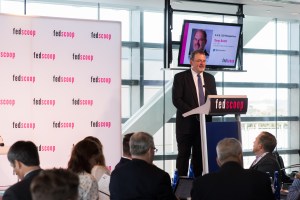Tony Scott calls IT workforce drain a ‘creeping’ crisis bigger than Y2K

The White House’s final IT modernization report will soon be released following nearly 100 comments from industry stakeholders, but former U.S. CIO Tony Scott is most concerned about a pair of issues that didn’t receive much attention in the plan: talent and culture.
The American Technology Council and Office of American Innovation’s draft report did address a bevy of issues surrounding IT modernization, but the White House technology teams must also examine how the government will replace its retiring technology workforce, especially the expertise surrounding maintaining aging legacy systems, Scott said t the Consortium for IT Software Quality’s Cyber Resilience Summit, part of Washington DC CyberWeek.
“I think it’s a crisis that’s bigger than Y2K. It’s just creeping up on us slowly, month by month, year by year,” he said, referring to the phenomenon of the late 1990s that potentially threatened to cripple global networks due to a bug in how computer commonly coded dates.
“But there is a point in the future where there’s just not going to be the knowledgeable resources to keep the old stuff going on the one hand, and then not enough resources to migrate off of those old things on the other hand,” said Scott, now leading his own IT consultancy, the TonyScottGroup, LLC. “It’s something that I think is a problem now and we need to really move aggressively to get it done.”
Scott added that he supports Rep. Will Hurd, R-Texas, in his plan to create a Cyber National Guard that brings private sector technology professionals to the federal government on a temporary but continuous basis to provide expertise on securing and innovating networks, much like the Army Naitonal Guard.
Hurd has promised forthcoming legislation codifying the Cyber National Guard after he secures passage of the Modernizing Government Technology Act, which passed the Senate as an amendment to the 2018 National Defense Authorization Act.
The other issue Scott said OAI and ATC must address is how it will build the government’s future IT ecosystem and gear it toward user experience, warning that it would be a mistake to just try and replace the old system without considering how to deploy it.
“It feels to me still like a lot of people have an orientation around, ‘Let’s just lift-and-shift these old legacy things that we have to a more modern platform,” he said. “Even if we were successful in doing that, we would still have the little siloes of information, little siloes of government, little siloes of architecture and so on.”
Scott said he favored a customer-based design for the federal government’s IT systems, identifying how to deliver on agency mission through design thinking.
“Whenever you throw [organizational] chart at a problem and it’s the basis for the technical design of what you are doing, I think you are starting in the wrong place,” he said.
Acting U.S. CIO Margie Graves said Wednesday at CyberTalks that the White House was incorporating insights derived from some 98 public comments into a final report that it would publish “very shortly.”






